实例介绍
【实例截图】
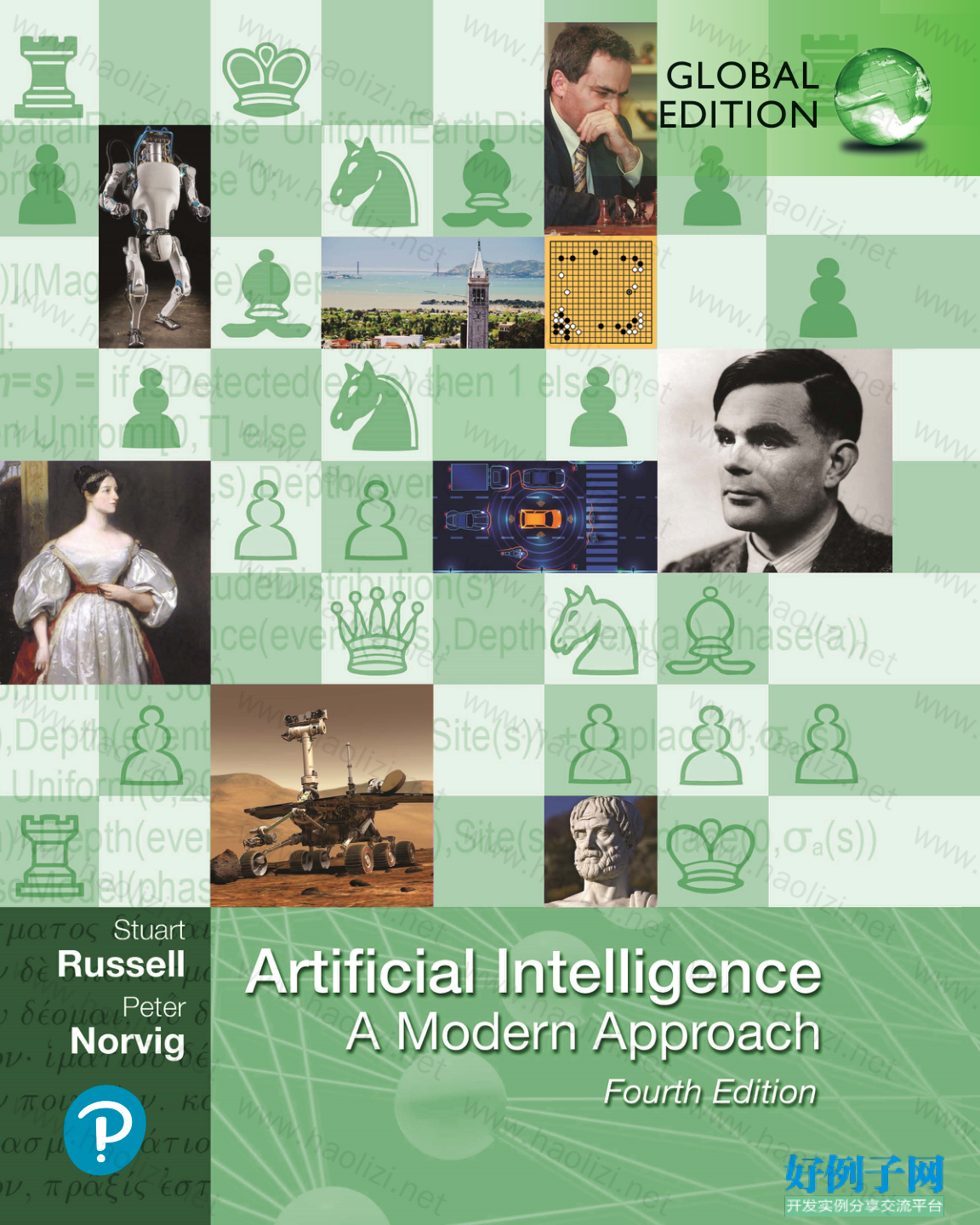
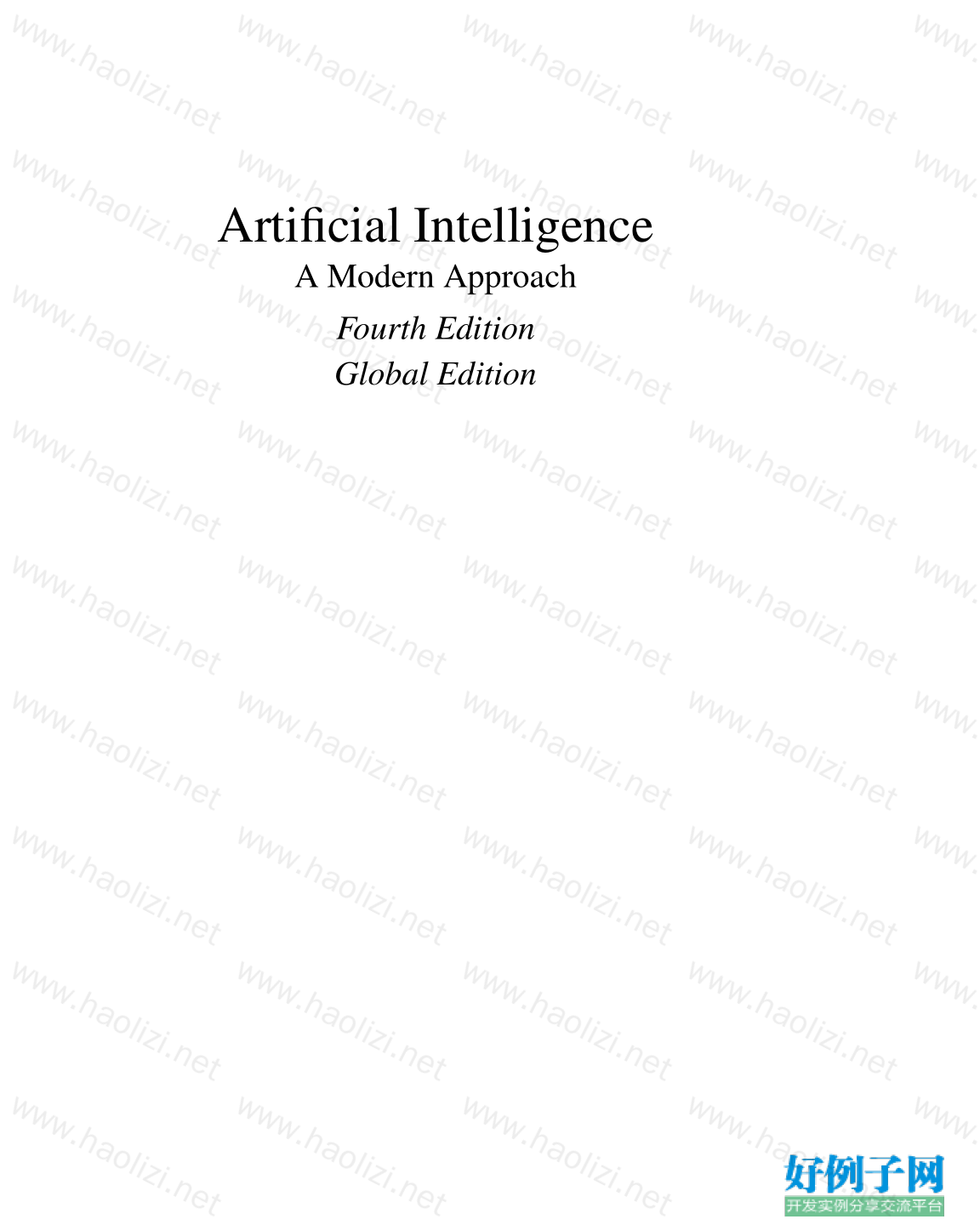

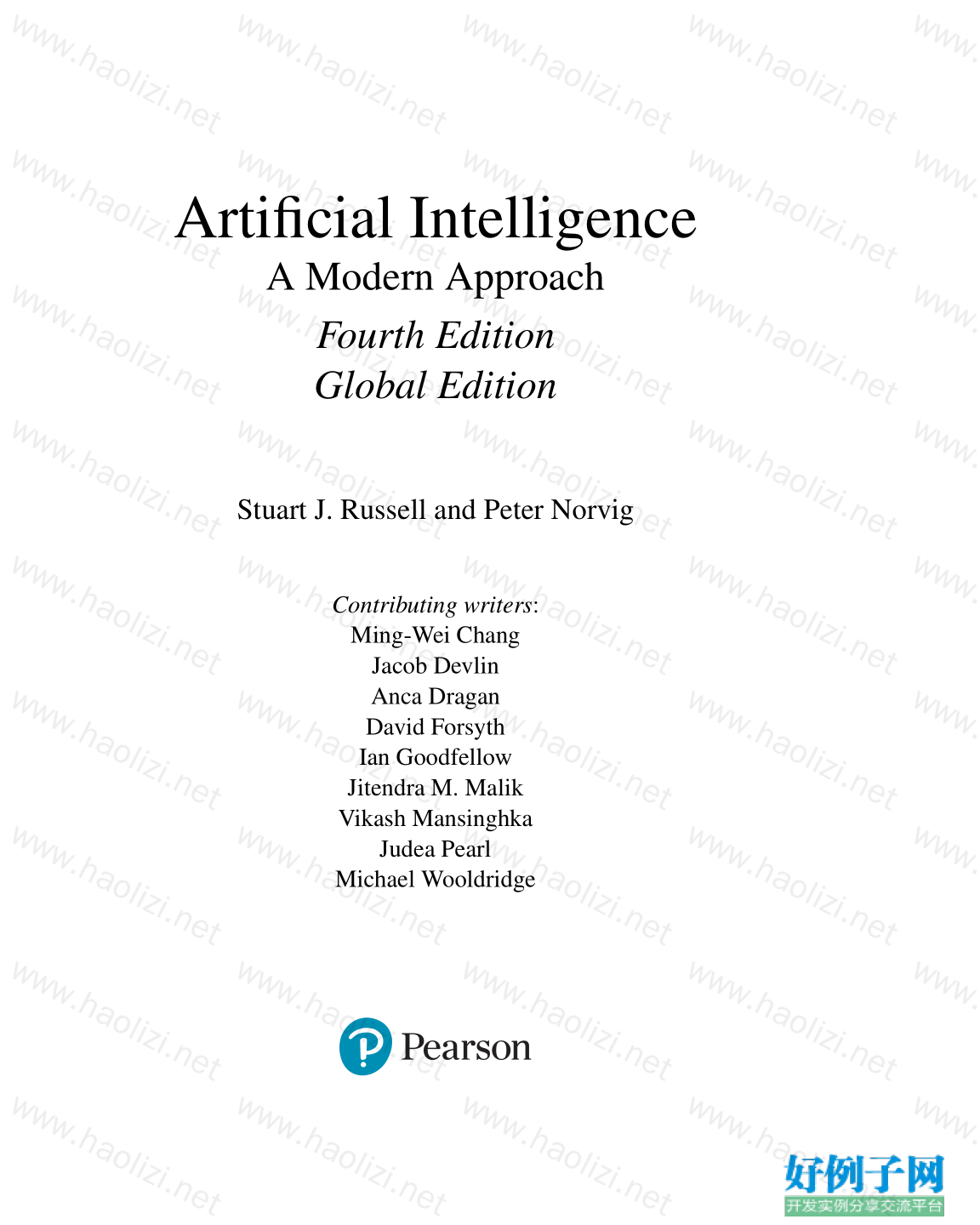


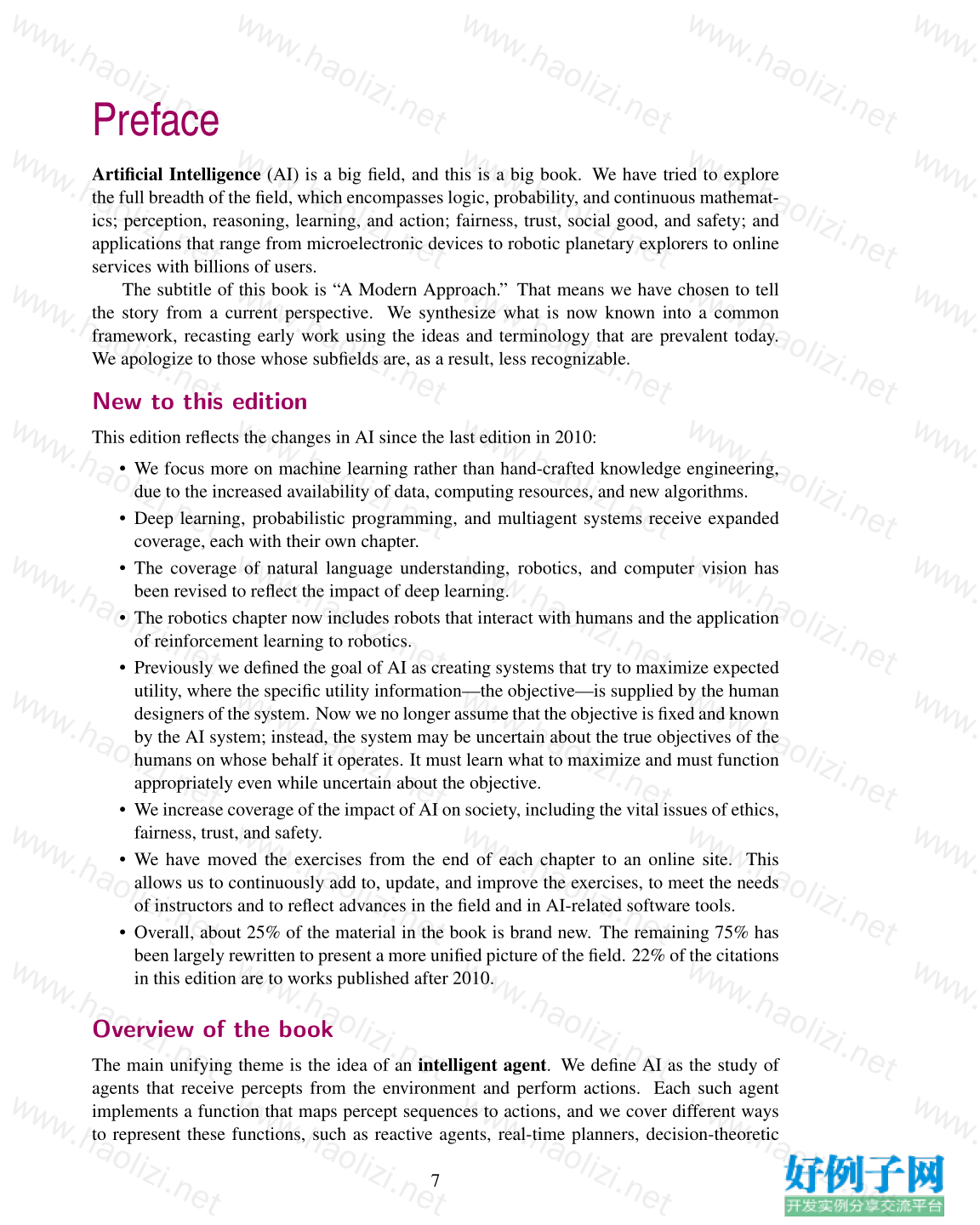
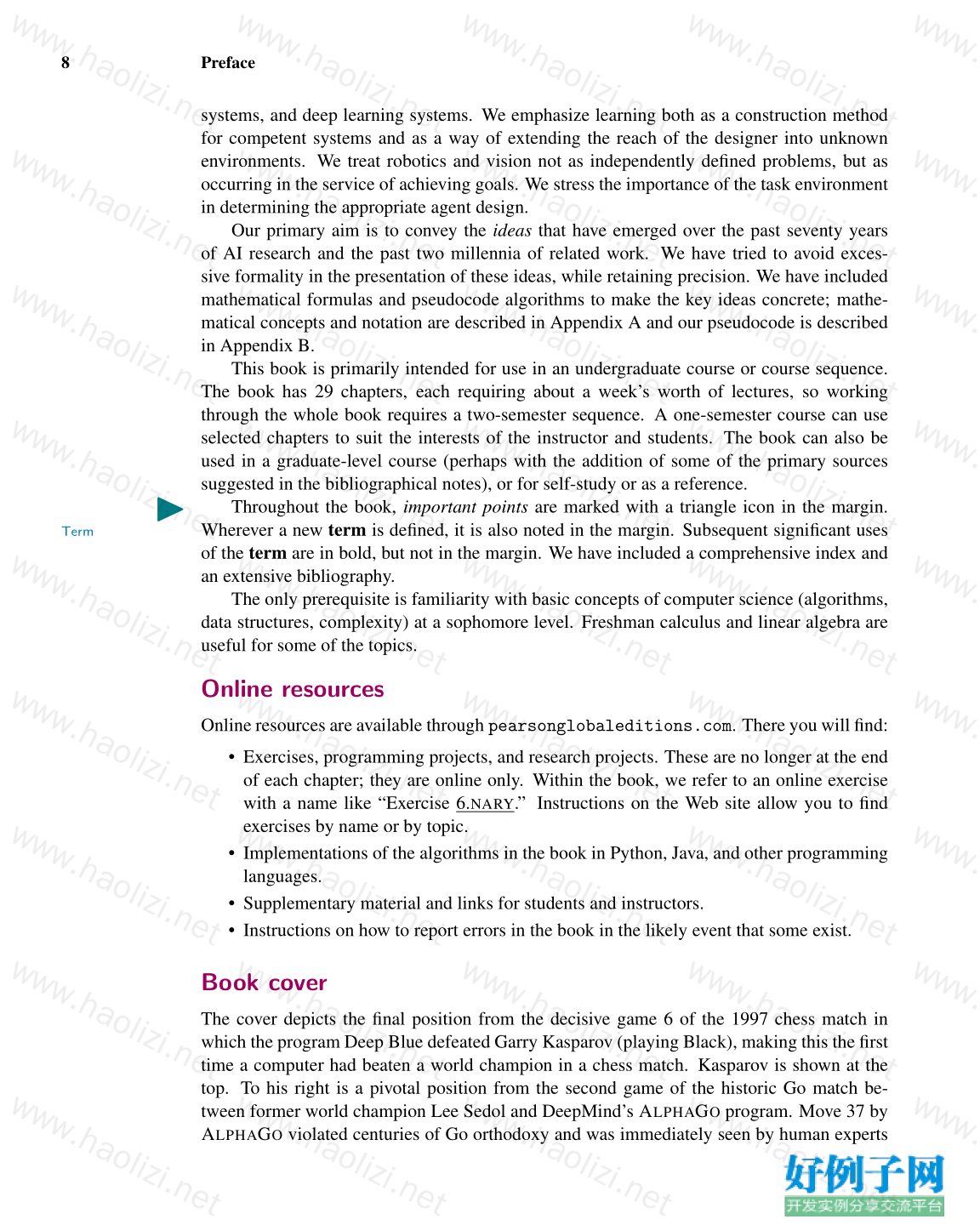
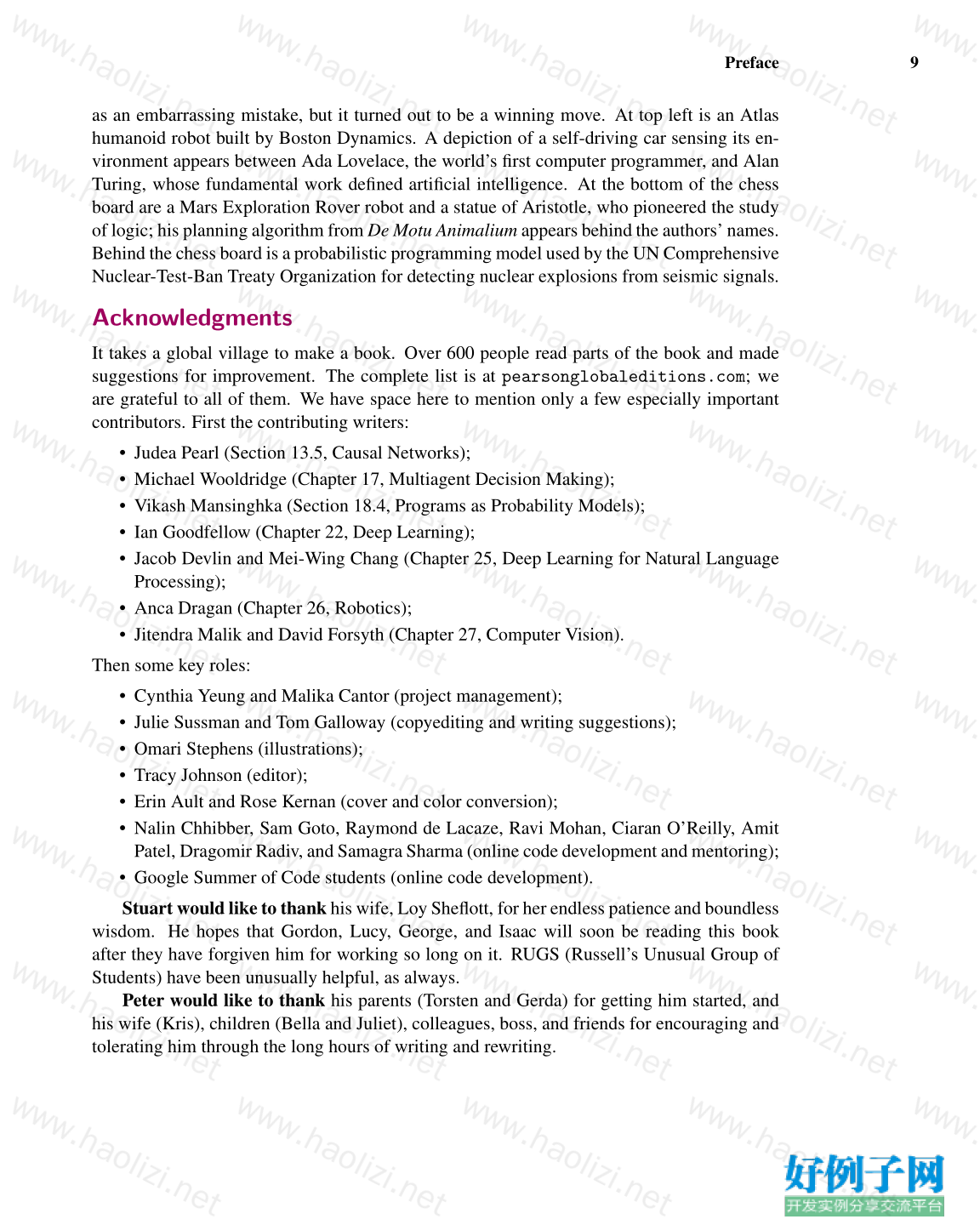



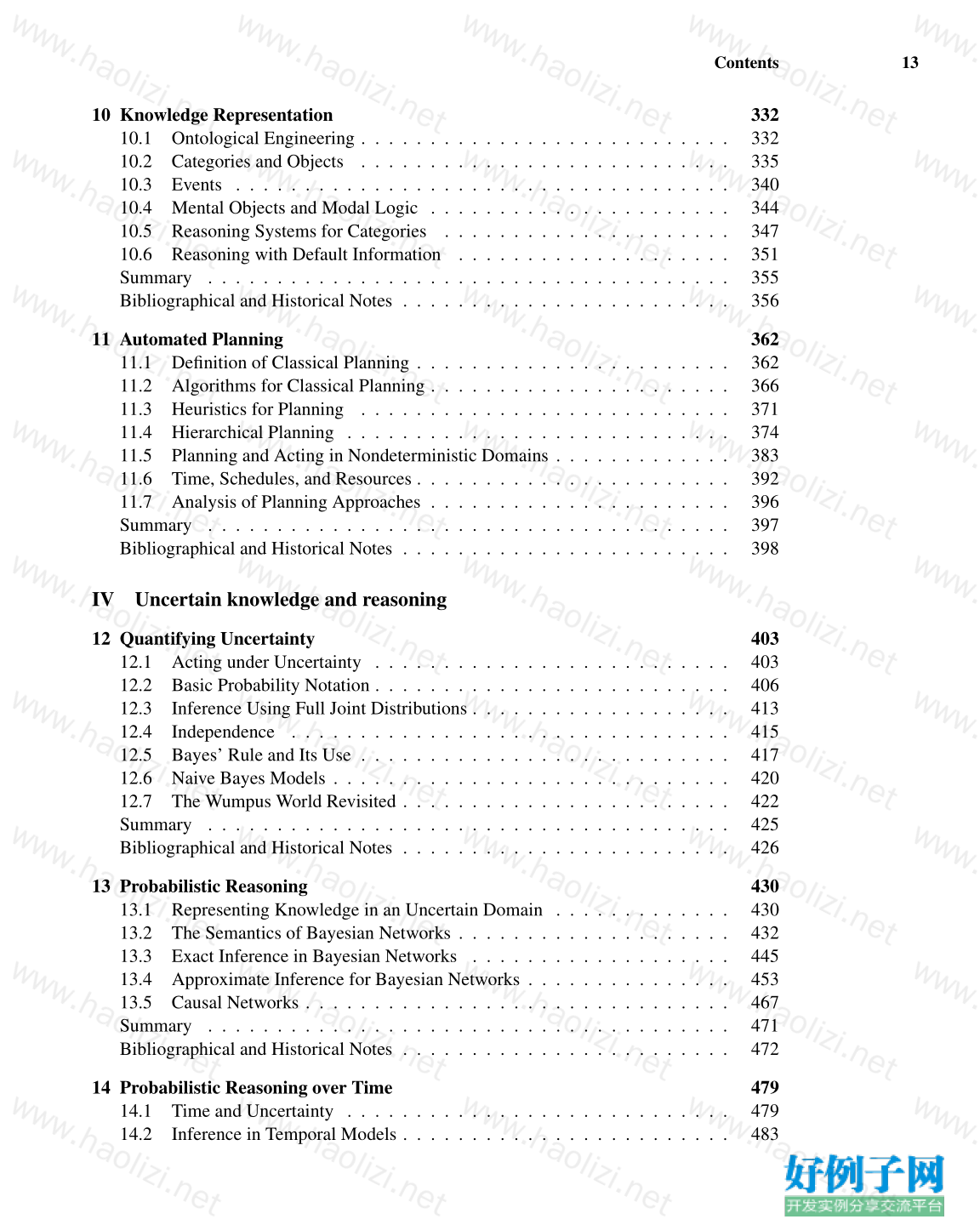
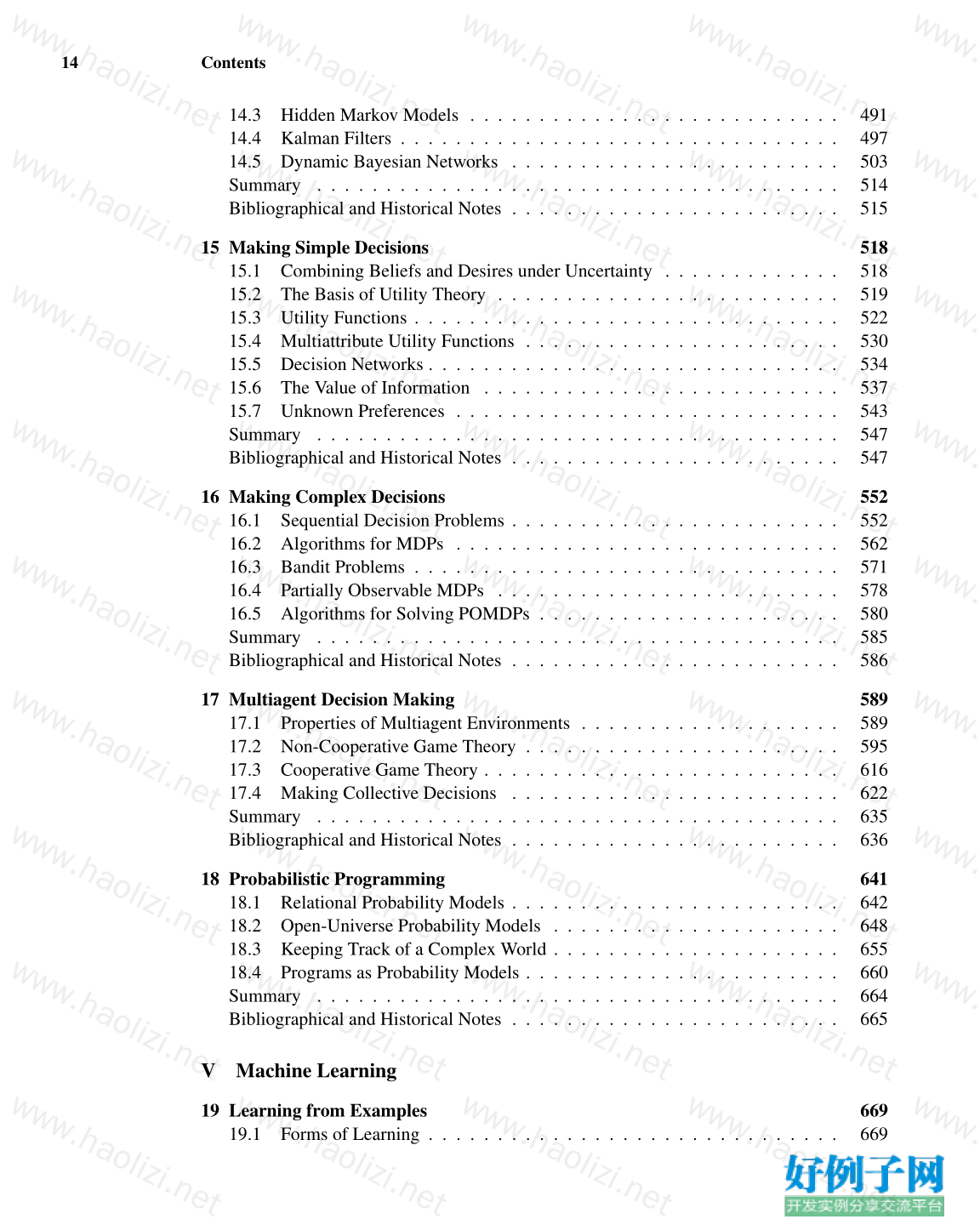


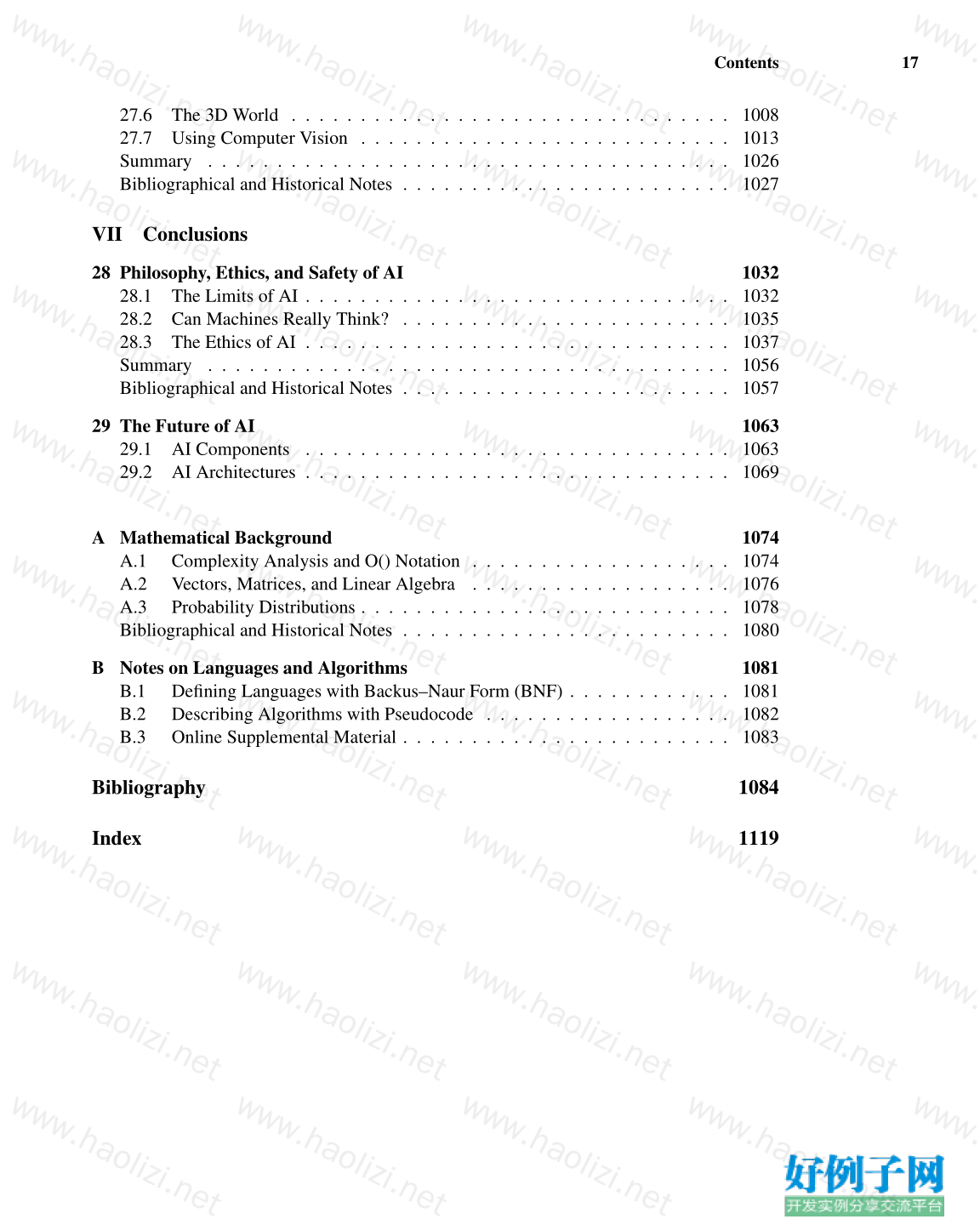
【核心代码】
Contents
I Artificial Intelligence
1 Introduction 19
1.1 What Is AI? . . . . . . . . . . . . . . . . . . . . . . . . . . . . . . . . . 19
1.2 The Foundations of Artificial Intelligence . . . . . . . . . . . . . . . . . . 23
1.3 The History of Artificial Intelligence . . . . . . . . . . . . . . . . . . . . 35
1.4 The State of the Art . . . . . . . . . . . . . . . . . . . . . . . . . . . . . 45
1.5 Risks and Benefits of AI . . . . . . . . . . . . . . . . . . . . . . . . . . . 49
Summary . . . . . . . . . . . . . . . . . . . . . . . . . . . . . . . . . . . . . . 52
Bibliographical and Historical Notes . . . . . . . . . . . . . . . . . . . . . . . . 53
2 Intelligent Agents 54
2.1 Agents and Environments . . . . . . . . . . . . . . . . . . . . . . . . . . 54
2.2 Good Behavior: The Concept of Rationality . . . . . . . . . . . . . . . . 57
2.3 The Nature of Environments . . . . . . . . . . . . . . . . . . . . . . . . . 60
2.4 The Structure of Agents . . . . . . . . . . . . . . . . . . . . . . . . . . . 65
Summary . . . . . . . . . . . . . . . . . . . . . . . . . . . . . . . . . . . . . . 78
Bibliographical and Historical Notes . . . . . . . . . . . . . . . . . . . . . . . . 78
II Problem-solving
3 Solving Problems by Searching 81
3.1 Problem-Solving Agents . . . . . . . . . . . . . . . . . . . . . . . . . . . 81
3.2 Example Problems . . . . . . . . . . . . . . . . . . . . . . . . . . . . . . 84
3.3 Search Algorithms . . . . . . . . . . . . . . . . . . . . . . . . . . . . . . 89
3.4 Uninformed Search Strategies . . . . . . . . . . . . . . . . . . . . . . . . 94
3.5 Informed (Heuristic) Search Strategies . . . . . . . . . . . . . . . . . . . 102
3.6 Heuristic Functions . . . . . . . . . . . . . . . . . . . . . . . . . . . . . 115
Summary . . . . . . . . . . . . . . . . . . . . . . . . . . . . . . . . . . . . . . 122
Bibliographical and Historical Notes . . . . . . . . . . . . . . . . . . . . . . . . 124
4 Search in Complex Environments 128
4.1 Local Search and Optimization Problems . . . . . . . . . . . . . . . . . . 128
4.2 Local Search in Continuous Spaces . . . . . . . . . . . . . . . . . . . . . 137
4.3 Search with Nondeterministic Actions . . . . . . . . . . . . . . . . . . . 140
4.4 Search in Partially Observable Environments . . . . . . . . . . . . . . . . 144
4.5 Online Search Agents and Unknown Environments . . . . . . . . . . . . 152
Summary . . . . . . . . . . . . . . . . . . . . . . . . . . . . . . . . . . . . . . 159
Bibliographical and Historical Notes . . . . . . . . . . . . . . . . . . . . . . . . 160
5 Constraint Satisfaction Problems 164
5.1 Defining Constraint Satisfaction Problems . . . . . . . . . . . . . . . . . 164
5.2 Constraint Propagation: Inference in CSPs . . . . . . . . . . . . . . . . . 169
11
12 Contents
5.3 Backtracking Search for CSPs . . . . . . . . . . . . . . . . . . . . . . . . 175
5.4 Local Search for CSPs . . . . . . . . . . . . . . . . . . . . . . . . . . . . 181
5.5 The Structure of Problems . . . . . . . . . . . . . . . . . . . . . . . . . . 183
Summary . . . . . . . . . . . . . . . . . . . . . . . . . . . . . . . . . . . . . . 187
Bibliographical and Historical Notes . . . . . . . . . . . . . . . . . . . . . . . . 188
6 Adversarial Search and Games 192
6.1 Game Theory . . . . . . . . . . . . . . . . . . . . . . . . . . . . . . . . 192
6.2 Optimal Decisions in Games . . . . . . . . . . . . . . . . . . . . . . . . 194
6.3 Heuristic Alpha–Beta Tree Search . . . . . . . . . . . . . . . . . . . . . 202
6.4 Monte Carlo Tree Search . . . . . . . . . . . . . . . . . . . . . . . . . . 207
6.5 Stochastic Games . . . . . . . . . . . . . . . . . . . . . . . . . . . . . . 210
6.6 Partially Observable Games . . . . . . . . . . . . . . . . . . . . . . . . . 214
6.7 Limitations of Game Search Algorithms . . . . . . . . . . . . . . . . . . 219
Summary . . . . . . . . . . . . . . . . . . . . . . . . . . . . . . . . . . . . . . 220
Bibliographical and Historical Notes . . . . . . . . . . . . . . . . . . . . . . . . 221
III Knowledge, reasoning, and planning
7 Logical Agents 226
7.1 Knowledge-Based Agents . . . . . . . . . . . . . . . . . . . . . . . . . . 227
7.2 The Wumpus World . . . . . . . . . . . . . . . . . . . . . . . . . . . . . 228
7.3 Logic . . . . . . . . . . . . . . . . . . . . . . . . . . . . . . . . . . . . . 232
7.4 Propositional Logic: A Very Simple Logic . . . . . . . . . . . . . . . . . 235
7.5 Propositional Theorem Proving . . . . . . . . . . . . . . . . . . . . . . . 240
7.6 Effective Propositional Model Checking . . . . . . . . . . . . . . . . . . 250
7.7 Agents Based on Propositional Logic . . . . . . . . . . . . . . . . . . . . 255
Summary . . . . . . . . . . . . . . . . . . . . . . . . . . . . . . . . . . . . . . 264
Bibliographical and Historical Notes . . . . . . . . . . . . . . . . . . . . . . . . 265
8 First-Order Logic 269
8.1 Representation Revisited . . . . . . . . . . . . . . . . . . . . . . . . . . 269
8.2 Syntax and Semantics of First-Order Logic . . . . . . . . . . . . . . . . . 274
8.3 Using First-Order Logic . . . . . . . . . . . . . . . . . . . . . . . . . . . 283
8.4 Knowledge Engineering in First-Order Logic . . . . . . . . . . . . . . . . 289
Summary . . . . . . . . . . . . . . . . . . . . . . . . . . . . . . . . . . . . . . 295
Bibliographical and Historical Notes . . . . . . . . . . . . . . . . . . . . . . . . 296
9 Inference in First-Order Logic 298
9.1 Propositional vs. First-Order Inference . . . . . . . . . . . . . . . . . . . 298
9.2 Unification and First-Order Inference . . . . . . . . . . . . . . . . . . . . 300
9.3 Forward Chaining . . . . . . . . . . . . . . . . . . . . . . . . . . . . . . 304
9.4 Backward Chaining . . . . . . . . . . . . . . . . . . . . . . . . . . . . . 311
9.5 Resolution . . . . . . . . . . . . . . . . . . . . . . . . . . . . . . . . . . 316
Summary . . . . . . . . . . . . . . . . . . . . . . . . . . . . . . . . . . . . . . 327
Bibliographical and Historical Notes . . . . . . . . . . . . . . . . . . . . . . . . 328
Contents 13
10 Knowledge Representation 332
10.1 Ontological Engineering . . . . . . . . . . . . . . . . . . . . . . . . . . . 332
10.2 Categories and Objects . . . . . . . . . . . . . . . . . . . . . . . . . . . 335
10.3 Events . . . . . . . . . . . . . . . . . . . . . . . . . . . . . . . . . . . . 340
10.4 Mental Objects and Modal Logic . . . . . . . . . . . . . . . . . . . . . . 344
10.5 Reasoning Systems for Categories . . . . . . . . . . . . . . . . . . . . . 347
10.6 Reasoning with Default Information . . . . . . . . . . . . . . . . . . . . 351
Summary . . . . . . . . . . . . . . . . . . . . . . . . . . . . . . . . . . . . . . 355
Bibliographical and Historical Notes . . . . . . . . . . . . . . . . . . . . . . . . 356
11 Automated Planning 362
11.1 Definition of Classical Planning . . . . . . . . . . . . . . . . . . . . . . . 362
11.2 Algorithms for Classical Planning . . . . . . . . . . . . . . . . . . . . . . 366
11.3 Heuristics for Planning . . . . . . . . . . . . . . . . . . . . . . . . . . . 371
11.4 Hierarchical Planning . . . . . . . . . . . . . . . . . . . . . . . . . . . . 374
11.5 Planning and Acting in Nondeterministic Domains . . . . . . . . . . . . . 383
11.6 Time, Schedules, and Resources . . . . . . . . . . . . . . . . . . . . . . . 392
11.7 Analysis of Planning Approaches . . . . . . . . . . . . . . . . . . . . . . 396
Summary . . . . . . . . . . . . . . . . . . . . . . . . . . . . . . . . . . . . . . 397
Bibliographical and Historical Notes . . . . . . . . . . . . . . . . . . . . . . . . 398
IV Uncertain knowledge and reasoning
12 Quantifying Uncertainty 403
12.1 Acting under Uncertainty . . . . . . . . . . . . . . . . . . . . . . . . . . 403
12.2 Basic Probability Notation . . . . . . . . . . . . . . . . . . . . . . . . . . 406
12.3 Inference Using Full Joint Distributions . . . . . . . . . . . . . . . . . . . 413
12.4 Independence . . . . . . . . . . . . . . . . . . . . . . . . . . . . . . . . 415
12.5 Bayes’ Rule and Its Use . . . . . . . . . . . . . . . . . . . . . . . . . . . 417
12.6 Naive Bayes Models . . . . . . . . . . . . . . . . . . . . . . . . . . . . . 420
12.7 The Wumpus World Revisited . . . . . . . . . . . . . . . . . . . . . . . . 422
Summary . . . . . . . . . . . . . . . . . . . . . . . . . . . . . . . . . . . . . . 425
Bibliographical and Historical Notes . . . . . . . . . . . . . . . . . . . . . . . . 426
13 Probabilistic Reasoning 430
13.1 Representing Knowledge in an Uncertain Domain . . . . . . . . . . . . . 430
13.2 The Semantics of Bayesian Networks . . . . . . . . . . . . . . . . . . . . 432
13.3 Exact Inference in Bayesian Networks . . . . . . . . . . . . . . . . . . . 445
13.4 Approximate Inference for Bayesian Networks . . . . . . . . . . . . . . . 453
13.5 Causal Networks . . . . . . . . . . . . . . . . . . . . . . . . . . . . . . . 467
Summary . . . . . . . . . . . . . . . . . . . . . . . . . . . . . . . . . . . . . . 471
Bibliographical and Historical Notes . . . . . . . . . . . . . . . . . . . . . . . . 472
14 Probabilistic Reasoning over Time 479
14.1 Time and Uncertainty . . . . . . . . . . . . . . . . . . . . . . . . . . . . 479
14.2 Inference in Temporal Models . . . . . . . . . . . . . . . . . . . . . . . . 483
14 Contents
14.3 Hidden Markov Models . . . . . . . . . . . . . . . . . . . . . . . . . . . 491
14.4 Kalman Filters . . . . . . . . . . . . . . . . . . . . . . . . . . . . . . . . 497
14.5 Dynamic Bayesian Networks . . . . . . . . . . . . . . . . . . . . . . . . 503
Summary . . . . . . . . . . . . . . . . . . . . . . . . . . . . . . . . . . . . . . 514
Bibliographical and Historical Notes . . . . . . . . . . . . . . . . . . . . . . . . 515
15 Making Simple Decisions 518
15.1 Combining Beliefs and Desires under Uncertainty . . . . . . . . . . . . . 518
15.2 The Basis of Utility Theory . . . . . . . . . . . . . . . . . . . . . . . . . 519
15.3 Utility Functions . . . . . . . . . . . . . . . . . . . . . . . . . . . . . . . 522
15.4 Multiattribute Utility Functions . . . . . . . . . . . . . . . . . . . . . . . 530
15.5 Decision Networks . . . . . . . . . . . . . . . . . . . . . . . . . . . . . . 534
15.6 The Value of Information . . . . . . . . . . . . . . . . . . . . . . . . . . 537
15.7 Unknown Preferences . . . . . . . . . . . . . . . . . . . . . . . . . . . . 543
Summary . . . . . . . . . . . . . . . . . . . . . . . . . . . . . . . . . . . . . . 547
Bibliographical and Historical Notes . . . . . . . . . . . . . . . . . . . . . . . . 547
16 Making Complex Decisions 552
16.1 Sequential Decision Problems . . . . . . . . . . . . . . . . . . . . . . . . 552
16.2 Algorithms for MDPs . . . . . . . . . . . . . . . . . . . . . . . . . . . . 562
16.3 Bandit Problems . . . . . . . . . . . . . . . . . . . . . . . . . . . . . . . 571
16.4 Partially Observable MDPs . . . . . . . . . . . . . . . . . . . . . . . . . 578
16.5 Algorithms for Solving POMDPs . . . . . . . . . . . . . . . . . . . . . . 580
Summary . . . . . . . . . . . . . . . . . . . . . . . . . . . . . . . . . . . . . . 585
Bibliographical and Historical Notes . . . . . . . . . . . . . . . . . . . . . . . . 586
17 Multiagent Decision Making 589
17.1 Properties of Multiagent Environments . . . . . . . . . . . . . . . . . . . 589
17.2 Non-Cooperative Game Theory . . . . . . . . . . . . . . . . . . . . . . . 595
17.3 Cooperative Game Theory . . . . . . . . . . . . . . . . . . . . . . . . . . 616
17.4 Making Collective Decisions . . . . . . . . . . . . . . . . . . . . . . . . 622
Summary . . . . . . . . . . . . . . . . . . . . . . . . . . . . . . . . . . . . . . 635
Bibliographical and Historical Notes . . . . . . . . . . . . . . . . . . . . . . . . 636
18 Probabilistic Programming 641
18.1 Relational Probability Models . . . . . . . . . . . . . . . . . . . . . . . . 642
18.2 Open-Universe Probability Models . . . . . . . . . . . . . . . . . . . . . 648
18.3 Keeping Track of a Complex World . . . . . . . . . . . . . . . . . . . . . 655
18.4 Programs as Probability Models . . . . . . . . . . . . . . . . . . . . . . . 660
Summary . . . . . . . . . . . . . . . . . . . . . . . . . . . . . . . . . . . . . . 664
Bibliographical and Historical Notes . . . . . . . . . . . . . . . . . . . . . . . . 665
V Machine Learning
19 Learning from Examples 669
19.1 Forms of Learning . . . . . . . . . . . . . . . . . . . . . . . . . . . . . . 669
Contents 15
19.2 Supervised Learning . . . . . . . . . . . . . . . . . . . . . . . . . . . . . 671
19.3 Learning Decision Trees . . . . . . . . . . . . . . . . . . . . . . . . . . . 675
19.4 Model Selection and Optimization . . . . . . . . . . . . . . . . . . . . . 683
19.5 The Theory of Learning . . . . . . . . . . . . . . . . . . . . . . . . . . . 690
19.6 Linear Regression and Classification . . . . . . . . . . . . . . . . . . . . 694
19.7 Nonparametric Models . . . . . . . . . . . . . . . . . . . . . . . . . . . 704
19.8 Ensemble Learning . . . . . . . . . . . . . . . . . . . . . . . . . . . . . 714
19.9 Developing Machine Learning Systems . . . . . . . . . . . . . . . . . . . 722
Summary . . . . . . . . . . . . . . . . . . . . . . . . . . . . . . . . . . . . . . 732
Bibliographical and Historical Notes . . . . . . . . . . . . . . . . . . . . . . . . 733
20 Knowledge in Learning 739
20.1 A Logical Formulation of Learning . . . . . . . . . . . . . . . . . . . . . 739
20.2 Knowledge in Learning . . . . . . . . . . . . . . . . . . . . . . . . . . . 747
20.3 Explanation-Based Learning . . . . . . . . . . . . . . . . . . . . . . . . 750
20.4 Learning Using Relevance Information . . . . . . . . . . . . . . . . . . . 754
20.5 Inductive Logic Programming . . . . . . . . . . . . . . . . . . . . . . . . 758
Summary . . . . . . . . . . . . . . . . . . . . . . . . . . . . . . . . . . . . . . 767
Bibliographical and Historical Notes . . . . . . . . . . . . . . . . . . . . . . . . 768
21 Learning Probabilistic Models 772
21.1 Statistical Learning . . . . . . . . . . . . . . . . . . . . . . . . . . . . . 772
21.2 Learning with Complete Data . . . . . . . . . . . . . . . . . . . . . . . . 775
21.3 Learning with Hidden Variables: The EM Algorithm . . . . . . . . . . . . 788
Summary . . . . . . . . . . . . . . . . . . . . . . . . . . . . . . . . . . . . . . 797
Bibliographical and Historical Notes . . . . . . . . . . . . . . . . . . . . . . . . 798
22 Deep Learning 801
22.1 Simple Feedforward Networks . . . . . . . . . . . . . . . . . . . . . . . 802
22.2 Computation Graphs for Deep Learning . . . . . . . . . . . . . . . . . . 807
22.3 Convolutional Networks . . . . . . . . . . . . . . . . . . . . . . . . . . . 811
22.4 Learning Algorithms . . . . . . . . . . . . . . . . . . . . . . . . . . . . . 816
22.5 Generalization . . . . . . . . . . . . . . . . . . . . . . . . . . . . . . . . 819
22.6 Recurrent Neural Networks . . . . . . . . . . . . . . . . . . . . . . . . . 823
22.7 Unsupervised Learning and Transfer Learning . . . . . . . . . . . . . . . 826
22.8 Applications . . . . . . . . . . . . . . . . . . . . . . . . . . . . . . . . . 833
Summary . . . . . . . . . . . . . . . . . . . . . . . . . . . . . . . . . . . . . . 835
Bibliographical and Historical Notes . . . . . . . . . . . . . . . . . . . . . . . . 836
23 Reinforcement Learning 840
23.1 Learning from Rewards . . . . . . . . . . . . . . . . . . . . . . . . . . . 840
23.2 Passive Reinforcement Learning . . . . . . . . . . . . . . . . . . . . . . 842
23.3 Active Reinforcement Learning . . . . . . . . . . . . . . . . . . . . . . . 848
23.4 Generalization in Reinforcement Learning . . . . . . . . . . . . . . . . . 854
23.5 Policy Search . . . . . . . . . . . . . . . . . . . . . . . . . . . . . . . . 861
23.6 Apprenticeship and Inverse Reinforcement Learning . . . . . . . . . . . . 863
16 Contents
23.7 Applications of Reinforcement Learning . . . . . . . . . . . . . . . . . . 866
Summary . . . . . . . . . . . . . . . . . . . . . . . . . . . . . . . . . . . . . . 869
Bibliographical and Historical Notes . . . . . . . . . . . . . . . . . . . . . . . . 870
VI Communicating, perceiving, and acting
24 Natural Language Processing 874
24.1 Language Models . . . . . . . . . . . . . . . . . . . . . . . . . . . . . . 874
24.2 Grammar . . . . . . . . . . . . . . . . . . . . . . . . . . . . . . . . . . . 884
24.3 Parsing . . . . . . . . . . . . . . . . . . . . . . . . . . . . . . . . . . . . 886
24.4 Augmented Grammars . . . . . . . . . . . . . . . . . . . . . . . . . . . . 892
24.5 Complications of Real Natural Language . . . . . . . . . . . . . . . . . . 896
24.6 Natural Language Tasks . . . . . . . . . . . . . . . . . . . . . . . . . . . 900
Summary . . . . . . . . . . . . . . . . . . . . . . . . . . . . . . . . . . . . . . 901
Bibliographical and Historical Notes . . . . . . . . . . . . . . . . . . . . . . . . 902
25 Deep Learning for Natural Language Processing 907
25.1 Word Embeddings . . . . . . . . . . . . . . . . . . . . . . . . . . . . . . 907
25.2 Recurrent Neural Networks for NLP . . . . . . . . . . . . . . . . . . . . 911
25.3 Sequence-to-Sequence Models . . . . . . . . . . . . . . . . . . . . . . . 915
25.4 The Transformer Architecture . . . . . . . . . . . . . . . . . . . . . . . . 919
25.5 Pretraining and Transfer Learning . . . . . . . . . . . . . . . . . . . . . . 922
25.6 State of the art . . . . . . . . . . . . . . . . . . . . . . . . . . . . . . . . 926
Summary . . . . . . . . . . . . . . . . . . . . . . . . . . . . . . . . . . . . . . 929
Bibliographical and Historical Notes . . . . . . . . . . . . . . . . . . . . . . . . 929
26 Robotics 932
26.1 Robots . . . . . . . . . . . . . . . . . . . . . . . . . . . . . . . . . . . . 932
26.2 Robot Hardware . . . . . . . . . . . . . . . . . . . . . . . . . . . . . . . 933
26.3 What kind of problem is robotics solving? . . . . . . . . . . . . . . . . . 937
26.4 Robotic Perception . . . . . . . . . . . . . . . . . . . . . . . . . . . . . . 938
26.5 Planning and Control . . . . . . . . . . . . . . . . . . . . . . . . . . . . 945
26.6 Planning Uncertain Movements . . . . . . . . . . . . . . . . . . . . . . . 963
26.7 Reinforcement Learning in Robotics . . . . . . . . . . . . . . . . . . . . 965
26.8 Humans and Robots . . . . . . . . . . . . . . . . . . . . . . . . . . . . . 968
26.9 Alternative Robotic Frameworks . . . . . . . . . . . . . . . . . . . . . . 975
26.10 Application Domains . . . . . . . . . . . . . . . . . . . . . . . . . . . . 978
Summary . . . . . . . . . . . . . . . . . . . . . . . . . . . . . . . . . . . . . . 981
Bibliographical and Historical Notes . . . . . . . . . . . . . . . . . . . . . . . . 982
27 Computer Vision 988
27.1 Introduction . . . . . . . . . . . . . . . . . . . . . . . . . . . . . . . . . 988
27.2 Image Formation . . . . . . . . . . . . . . . . . . . . . . . . . . . . . . . 989
27.3 Simple Image Features . . . . . . . . . . . . . . . . . . . . . . . . . . . 995
27.4 Classifying Images . . . . . . . . . . . . . . . . . . . . . . . . . . . . . . 1002
27.5 Detecting Objects . . . . . . . . . . . . . . . . . . . . . . . . . . . . . . 1006
Contents 17
27.6 The 3D World . . . . . . . . . . . . . . . . . . . . . . . . . . . . . . . . 1008
27.7 Using Computer Vision . . . . . . . . . . . . . . . . . . . . . . . . . . . 1013
Summary . . . . . . . . . . . . . . . . . . . . . . . . . . . . . . . . . . . . . . 1026
Bibliographical and Historical Notes . . . . . . . . . . . . . . . . . . . . . . . . 1027
VII Conclusions
28 Philosophy, Ethics, and Safety of AI 1032
28.1 The Limits of AI . . . . . . . . . . . . . . . . . . . . . . . . . . . . . . . 1032
28.2 Can Machines Really Think? . . . . . . . . . . . . . . . . . . . . . . . . 1035
28.3 The Ethics of AI . . . . . . . . . . . . . . . . . . . . . . . . . . . . . . . 1037
Summary . . . . . . . . . . . . . . . . . . . . . . . . . . . . . . . . . . . . . . 1056
Bibliographical and Historical Notes . . . . . . . . . . . . . . . . . . . . . . . . 1057
29 The Future of AI 1063
29.1 AI Components . . . . . . . . . . . . . . . . . . . . . . . . . . . . . . . 1063
29.2 AI Architectures . . . . . . . . . . . . . . . . . . . . . . . . . . . . . . . 1069
A Mathematical Background 1074
A.1 Complexity Analysis and O() Notation . . . . . . . . . . . . . . . . . . . 1074
A.2 Vectors, Matrices, and Linear Algebra . . . . . . . . . . . . . . . . . . . 1076
A.3 Probability Distributions . . . . . . . . . . . . . . . . . . . . . . . . . . . 1078
Bibliographical and Historical Notes . . . . . . . . . . . . . . . . . . . . . . . . 1080
B Notes on Languages and Algorithms 1081
B.1 Defining Languages with Backus–Naur Form (BNF) . . . . . . . . . . . . 1081
B.2 Describing Algorithms with Pseudocode . . . . . . . . . . . . . . . . . . 1082
B.3 Online Supplemental Material . . . . . . . . . . . . . . . . . . . . . . . . 1083
Bibliography 1084
Index 1119
相关软件
小贴士
感谢您为本站写下的评论,您的评论对其它用户来说具有重要的参考价值,所以请认真填写。
- 类似“顶”、“沙发”之类没有营养的文字,对勤劳贡献的楼主来说是令人沮丧的反馈信息。
- 相信您也不想看到一排文字/表情墙,所以请不要反馈意义不大的重复字符,也请尽量不要纯表情的回复。
- 提问之前请再仔细看一遍楼主的说明,或许是您遗漏了。
- 请勿到处挖坑绊人、招贴广告。既占空间让人厌烦,又没人会搭理,于人于己都无利。
关于好例子网
本站旨在为广大IT学习爱好者提供一个非营利性互相学习交流分享平台。本站所有资源都可以被免费获取学习研究。本站资源来自网友分享,对搜索内容的合法性不具有预见性、识别性、控制性,仅供学习研究,请务必在下载后24小时内给予删除,不得用于其他任何用途,否则后果自负。基于互联网的特殊性,平台无法对用户传输的作品、信息、内容的权属或合法性、安全性、合规性、真实性、科学性、完整权、有效性等进行实质审查;无论平台是否已进行审查,用户均应自行承担因其传输的作品、信息、内容而可能或已经产生的侵权或权属纠纷等法律责任。本站所有资源不代表本站的观点或立场,基于网友分享,根据中国法律《信息网络传播权保护条例》第二十二与二十三条之规定,若资源存在侵权或相关问题请联系本站客服人员,点此联系我们。关于更多版权及免责申明参见 版权及免责申明



网友评论
我要评论